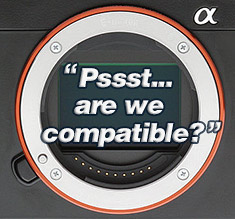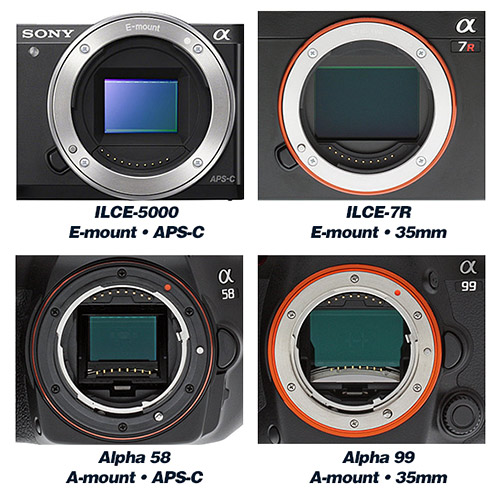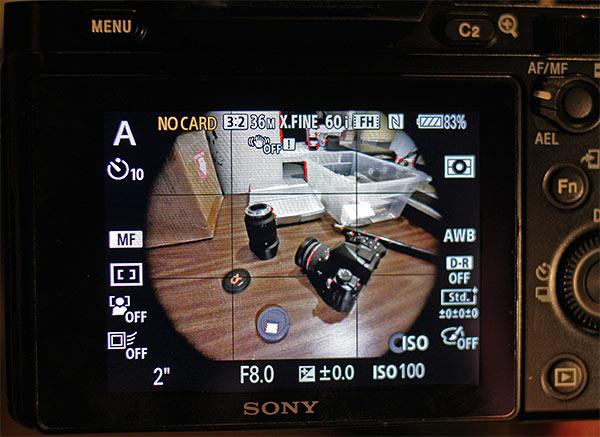Mounting Confusion: De-mystifying Sony lens mounts
posted Tuesday, January 21, 2014 at 7:25 PM EST

[Special editor's note: This article was written in early 2014, more than two years ago, and at that time there was rampant confusion over Sony lens mount schemes. They have long since taken steps to allay confusion on their site, so please understand when reading that this article may help guide you, but it was written in a much different time and therefore parts of it are no longer necessarily reflective of the present.]
Sony's decision to drop the "NEX" moniker from its associated line within the Alpha scheme created a sea of confusion for many an NEX shooter, and for potential NEX buyers as well. "Are they going to stop making NEX cameras?" "Will the E-mount disappear altogether?" "Should I even consider buying a current NEX model?"
These are valid questions, and I can assure you that we who are presumably "in the know" had been scratching our heads as well. As you may have read in our previous post surrounding this topic, though, it does now appear that the NEX line is alive and well, as is the E-mount (and presumably new lenses to come) while only the product-line name "NEX" is disappearing. This is welcome news to us at IR, and I'm sure to most all NEX fans out there.
The NEX marketing curveball did bring up another topic of confusion though: Sony lens mounts. It was such a simple and easy world for Sony shooters when NEX models used E-mount lenses and Alpha models used A-mount lenses. What a great little scheme… and now it's gone with the wind, folks. But as Gale Snopes said in Raising Arizona: "We'd rather light a candle than curse your darkness." So here's our best shot at de-mystifying the confusing mish-mash of mounts, lenses, bodies, and image circles in the current Sony line-up.
Going forward, all Sony interchangeable-lens cameras will be called Alphas. This includes new E-mount cameras that would have said "NEX" (like the Alpha ILCE-5000), a recent E-mount mirrorless camera built to look like a DSLR (the ILCE-3000), the APS-C Alpha cameras with A-mounts (like the A77), the Alpha full-frame cameras with A-mounts (like the A99), and the newer Alpha full-frame mirrorless cameras with the full-frame E-mount (the first two models are the Alpha ILCE-7 and ILCE-7R) are now all Alphas. They actually already were all Alphas, but the whole "NEX" thing apparently confused too many people into believing otherwise. But it's simple enough now, right? One big happy family? Well, sort of...
The real fun starts when you try and figure out the lens schemes. The Alpha ILCE-3000 from 2013 and the newly announced Alpha ILCE-5000 are mirrorless cameras with APS-C sized sensors that accept E-mount lenses. However, these two cameras do not look like they belong in the same family, as the A3000 looks like a DSLR and the A5000 looks like an NEX, and yet the two cameras are quite similar in many respects. We're not supposed to use the letter "A" to stand in for Alpha, and NEX no longer exists, but the actual greek letter alpha isn't on my keyboard, and nobody bothers to spell out Alpha when they're talking about Sony model names, so forgive my political incorrectness. In any event, stay with me...

The most recent APS-C Alpha before the extinction of the NEX name was the A58, which accepts A-mount lenses like the previously mentioned A77 (APS-C) and A99 (full frame). Some A-mount lenses say "DT", which means they're for APS-C cameras. If you place one onto a full-frame A-mount camera and try to shoot, the corners will darken unless you instruct the camera to pre-crop to fit the lens. No problem going the other way of course, the smaller APS-C sensor just doesn't take advantage of the full image circle a full-frame A-mount lens produces.
The fun continues with the newest Sony full-frame models, the Alpha ILCE-7 and ILCE-7R, which sport the same E-mount as used on the former NEX line, but now require the new "FE" lenses to provide full-frame image coverage. When E-mount lenses are attached to FE-capable cameras, a similar situation occurs as in the A-mount scenario mentioned above, in that you'll experience vignetting in the image unless you instruct the camera to crop its images to match the smaller image circle. The setting is called "APS-C size capture", and can be set to on, off and auto.

While the text above spells out all the details, combinations and permutations of Sony lens mounts, we thought gathering the information into a table might help make matters a bit more clear.
| Lens Mount/Type |
Lens Type Modifier |
Image Circle |
Body Compatibility (No Adapter) |
Body Compatibility (With Adapter) |
| A-Mount | none | Full-Frame | All A-mount bodies | Any E-mount body |
| A-Mount | DT | APS-C |
Sub-frame A-mount Full-frame A-mount w/cropping |
Any E-mount body, w/cropping on Full-Frame E-mount |
| E-Mount | None | APS-C |
Sub-frame E-mount Full-frame E-mount w/cropping |
n/a |
| E-Mount | FE | Full-Frame | All E-mount bodies | n/a |
Of course, there are adapters available, to let you connect Sony's older A-mount lenses to the new E-mount bodies. Here's a rundown of the four types available. (Note that the first two have been replaced by the second two, the only difference is that the two newer ones support a full-frame image circle, as with the A7 and A7R.)
| Adapter Model | Function |
|
LA-EA1 (Discontinued) |
Adapts A-Mount lenses to sub-frame E-mount cameras, using the camera's contrast-detect focusing (generally quite slow and/or may not work well with older A-mount lenses). Now discontinued. |
|
LA-EA2 (Discontinued) |
Adapts A-Mount lenses to sub-frame E-mount cameras, with a built-in Translucent Mirror phase-detect AF system. Now discontinued. |
| LA-EA3 | Adapts A-Mount lenses to all E-mount cameras, using the camera's contrast-detect focusing (generally quite slow and/or may not work well with older A-mount lenses). An aperture drive mechanism enables Auto-Exposure with all A-mount lenses except teleconverters. Replaces LA-EA1. |
| LA-EA4 | Adapts A-Mount lenses to all E-mount cameras, with a built-in Translucent Mirror 15-point phase-detect AF system. An aperture drive mechanism enables Auto-Exposure with all A-mount lenses except teleconverters. (In video mode, aperture is fixed at the maximum aperture of the lens or f/3.5, whichever is lower.) Replaces LA-EA2. |
So there you have it, lens fans... welcome to the new world order for Sony lenses and mounts.
• • •
More recent Sony lens articles you might enjoy:
Sony FE 70-300mm G Initial Impressions and Gallery
First real-world images from Sony's new G Master lenses
Sony A6000 + Sony 90mm f/2.8 FE = a popular portrait pairing
Sony 55mm FE on an A5100:
Why stick a $1000 lens on a $500 body? Well… lots of reasons!